A porous border and the river of steel: Weapons trafficked from US bleed Mexico dry
According to the most conservative studies, some 17 million weapons circulate illegally in Mexico. The vast majority come from the United States
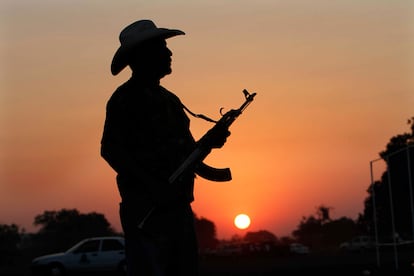
For decades, the border between Mexico and the United States was just an imaginary line, a figment of our imagination. People, animals, and merchandise passed through the almost 2,000 miles of frontier that divide the two countries. Legal and illegal were then only words, adjectives in the dictionary, not yet linked to the river or the desert. In the second part of the 20th century, barriers and wire fences began to be erected. In recent years, the construction of concrete walls began. The passage from south to north became more complicated. What was once imaginary became material. Today, outlandish patrols, bird drones and laser sensors are roaming the border, hungry for movement, drugs, and people. There are detection towers, huge searchlights, and high-definition cameras on every stretch of an increasingly guarded border. From south to north.
The passage from the U.S. into Mexico is another matter. There is no need to hide. The “Welcome to Mexico” sign is usually accompanied by a cursory glance from the customs inspector. There are no regular checks on the 150,000 cars that cross the border southbound every day. The entire infrastructure is built to prevent the flow of unwanted people and goods from south to north, not the other way around. And so, the food for the violence that is bleeding the country. It’s a simple, million-dollar business. Trafficking weapons into Mexico is child’s play.
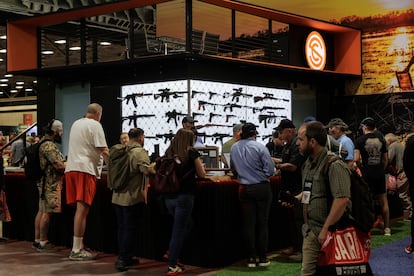
A border that divides a market
The U.S.-Mexico border marks the division of two completely different ways of regulating access to guns. In 2023, there were 77,813 outlets in the United States where guns could be purchased legally. That is a number similar to the combined amount of McDonald’s, Burger King, Subway, and Wendy’s restaurants in the entire United States; or the equivalent of four and a half times the number of Starbucks coffee shops. In Mexico, on the other hand, there are only two centers for legally acquiring firearms, both administered by the Secretariat of National Defense (Sedena).
In several states north of the border, it doesn’t require more than a short background check and being 18 years old to purchase an assault rifle. Or two. Or three. Or 10. In Mexico, Sedena regulates strict and complex procedures to legally acquire a low-caliber revolver. Outside the state’s lens, however, via WhatsApp or through small-time dealers, the avid buyer can get a “goat horn,” as an AK-47 is colloquially known in Mexico, in a few hours. It is just a matter of knowing how and where to look for one of the 17 million weapons that, according to the most conservative studies, circulate illegally in Mexico.
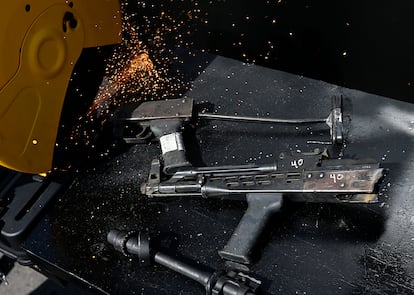
The largest arms market in the world
The United States is the largest arms market in the world. In 2022, more than 13.4 million firearms were manufactured, enough to supply the entire population of countries like Greece, Portugal, or Sweden. And it is a growing industry. Two decades ago, in 2001, just under three million were manufactured. Or, to put it another way, in 21 years the U.S. population grew by 18%, but the number of guns produced quadrupled.
But there is an uncomfortable truth among gun lovers in the United States, one that sellers and buyers alike face without enthusiasm. It is a truth that calls into question the very Americanness of the market. It’s simple: the world exports guns to the United States. And increasingly so. The business has long since ceased to be “made in the U.S.” In 2021, the world exported nearly seven million weapons to the U.S., 392% more than 20 years ago.
Research published in 2024 estimated that about 378 million firearms were in circulation in the United States (not counting 3D printed or automatically produced guns). In a country of around 332 million people. This means that there are about 114 firearms in circulation for every 100 inhabitants. That is similar to the estimated number of cell phones per capita in the United States (116 per 100) and higher than the number of automobiles per capita (90 per 100).
In comparative terms, the number of guns in the United States is out of proportion. The next country on the list with the highest rate of gun ownership is Yemen, which has 52.8 firearms per 100 people. And Yemen has been embroiled in a civil war since 2014.
Of course, guns are not evenly distributed among citizens. The trend in the United States is uneven: fewer and fewer Americans own more and more guns. According to the most reliable surveys, 3% of the adult population of the United States owns about half of the guns in circulation, while 8% of gun owners own 10 or more guns.
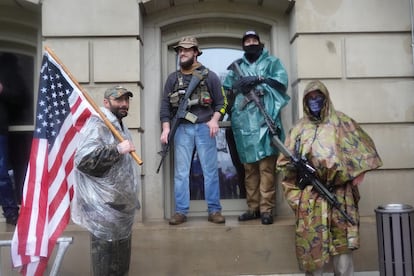
The river of steel: trafficked arms
The lack of regulation to acquire weapons in the United States, the enormous demand for them in Mexico, and the porosity of the border are the three factors that enable a market that is impossible to contain. They generate a river of steel without pause and without respite.
A study by the University of San Diego and the Igarapé Institute estimated in 2013 that some 253,000 weapons were trafficked into Mexico each year. Or, in other words, some 693 weapons per day, or 28 per hour. In another exercise, Mexico’s Foreign Ministry calculated two million weapons were trafficked in the last decade. The real figures are impossible to establish.
A central source for approaching the issue is data from the Bureau of Alcohol, Tobacco, Firearms and Explosives (ATF) based on traceability tests of weapons found at crime scenes in Mexico, the Caribbean, and Central America. Consistently, these studies show that approximately 70% of guns found at crime scenes in Mexico were manufactured in the United States before being illegally trafficked into the country. In the period 2017-2021, the majority of those guns were purchased from retailers in Texas (43%), Arizona (17%), and California (13%).
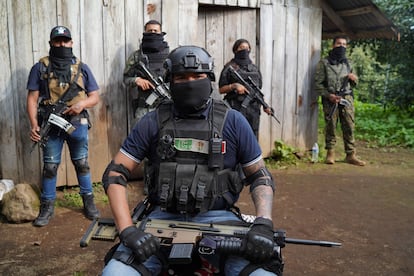
Gun trafficking from the United States to Mexico involves networks of all sizes. In some cases, it is the Mexican cartels themselves that manage to maintain their own steady source of weapons. In other cases, those responsible for the illegal trafficking are independent networks that serve as arms suppliers to several different cartels. A recent ATF publication showed that traffickers who directly or indirectly facilitated the movement of firearms into illegal markets tend to be white (53%), male (84%), and U.S. citizens (95%). Claims that the main perpetrators are foreigners are false.
In recent years, a new modus operandi has become very common: the shipment of gun parts by parcel to Mexico to be assembled there. In 2023, the U.S. Attorney’s Office for the Western District of Texas charged an individual named Chandler Britain Bradford with trafficking AR-15 rifle parts and components from the United States to Mexico between 2018 and 2022. According to the indictment, Bradford shipped by parcel or carried directly 70 parts and components that constitute an AR-15 to Monterrey. His associates in Mexico did the assembly work. According to the prosecution’s indictment, in four years of operation, Bradford received $3.5 million as a result of the operations. In exchange, Bradford’s partners in Mexico were able to assemble at least 4,800 semi-automatic rifles in four years. Bradford’s is one of hundreds of investigations the ATF opens each year into illegal arms trafficking in the United States. A needle in a haystack.
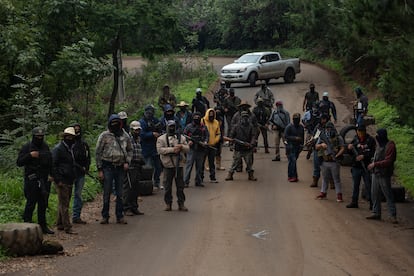
First guns, then diversification, and finally violence
Weapons in Mexico have not only served to kill. Their most profound impact is that they have functioned as vectors for the expansion of criminal networks in the region. Firearms have allowed criminal circuits limited in size and power to challenge state authority to previously unimaginable dimensions. They have been the enabling factor in the growth from small networks to large armies with the capacity to dominate cities. Without firearms, territorial expansion would not have been possible.
Access to firearms enabled the diversification of the criminal market in Mexico. For decades, dozens of criminal groups dedicated themselves to drug trafficking without engaging in other crimes. Since the relaxation of laws in the United States in 2004-2005, this has changed. Easy access to weapons allowed them to build up a sufficiently large dispensary that made it easy for them to enter other businesses. The logic was very simple: if we already have the weapons, why not take advantage of them and use them?

Under this premise, the cartels ventured into new niches: human trafficking, extortion, commercial robbery, and contract assassinations. Every crime imaginable. They acted as what they are: capitalists looking for opportunities. Entrepreneurs. They besieged entire cities and challenged (or ended up challenging) the local police, who could do little in the face of the firepower of the weapons coming from the north.
Today, the Mexican state faces a very different criminal problem than it did 15 years ago. It is a different bug, a different animal. Firearms have empowered criminal organizations and challenged the state’s ability to deal with them.
There will be no possible respite for Mexico as long as the river of steel keeps flowing. No judicial or police reform can withstand the fury of too many guns. There will be no desirable demilitarization or democratic normalcy. As long as the river continues to carry steel and the border remains porous, Mexico will remain doomed to its epidemic of violence. Therein lies the problem. Therein also lies the solution.
Sign up for our weekly newsletter to get more English-language news coverage from EL PAÍS USA Edition
Tu suscripción se está usando en otro dispositivo
¿Quieres añadir otro usuario a tu suscripción?
Si continúas leyendo en este dispositivo, no se podrá leer en el otro.
FlechaTu suscripción se está usando en otro dispositivo y solo puedes acceder a EL PAÍS desde un dispositivo a la vez.
Si quieres compartir tu cuenta, cambia tu suscripción a la modalidad Premium, así podrás añadir otro usuario. Cada uno accederá con su propia cuenta de email, lo que os permitirá personalizar vuestra experiencia en EL PAÍS.
¿Tienes una suscripción de empresa? Accede aquí para contratar más cuentas.
En el caso de no saber quién está usando tu cuenta, te recomendamos cambiar tu contraseña aquí.
Si decides continuar compartiendo tu cuenta, este mensaje se mostrará en tu dispositivo y en el de la otra persona que está usando tu cuenta de forma indefinida, afectando a tu experiencia de lectura. Puedes consultar aquí los términos y condiciones de la suscripción digital.
More information
Chiapas, captive territory
Archived In
Últimas noticias
Most viewed
- Sinaloa Cartel war is taking its toll on Los Chapitos
- Oona Chaplin: ‘I told James Cameron that I was living in a treehouse and starting a permaculture project with a friend’
- Reinhard Genzel, Nobel laureate in physics: ‘One-minute videos will never give you the truth’
- Why the price of coffee has skyrocketed: from Brazilian plantations to specialty coffee houses
- Silver prices are going crazy: This is what’s fueling the rally









































